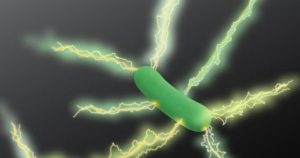PhD opportunity at the Quantum Biology Doctoral Training Centre (QB-DTC) to study energy generation through electrogenic organism microsystems.
Posted 2nd June 2019
- Explore the electron transport mechanisms between membrane cytrochromes and electrode along pili. Is this a classical conductive transport, is it ion transport, or does it involve quantum tunnelling along a series of Fe-S clusters? For example, the quantum extension of the classical Drude theory of metal conductivity shows that regularly spaced potential wells (positive metal atom core) can achieve nearly 100% electron permeability through superposition of quantum wave packets. What permeability rates can the (regular) potential wells associated with geometrical arrangement of FeS clusters in pili achieve?
- So far, bio-electricity has been produced using metallic (or carbon) electrodes as the interface between the microbial electro-generation and the electric load. We want to examine here how using a semiconductor as the electrode influences the microbial metabolism and therefore electron transfer.
- Semiconductors are characterised by the energy-band gaps for electrons, implying that electrons in them can exist only on discrete potential / energy levels (as opposed to metals or carbon). Therefore, the electron donation process from microorganism is constrained by these potential bands. Consequently microorganisms cannot change the energy-level at which they are donating electrons continuously, but only in discrete steps. How does this influence the composition and metabolism of a microbial species (or a microbial community) with respect to its electrogenicity?
- Use semiconductor electrodes to create a varied and differentiated microbial community. Quantum effects allow to have a marked potential gradient along the surface of an electrode, and therefore electrogenic microbes with a preferred donation voltage would group better in the region where this potential exists along the gradient on the electrode surface. This potential gradient will allow for a completely new and efficient way to analyse the electrogenic behaviour in a multi-species community by differentiating the electric habitat along the gradient, while all the species still share a common biochemical habitat. This would allow for new communities to evolve that perhaps can metabolise incoming organic waste more efficiently: each species could donate electrons to the electrode at their preferred potential while still allowing exchange of partial oxidised organic compounds between them.
